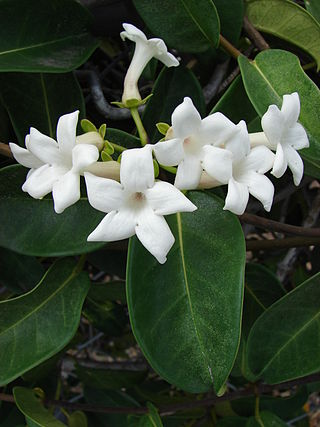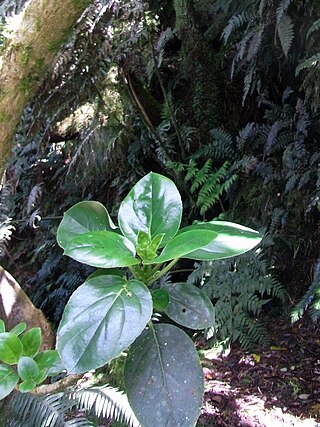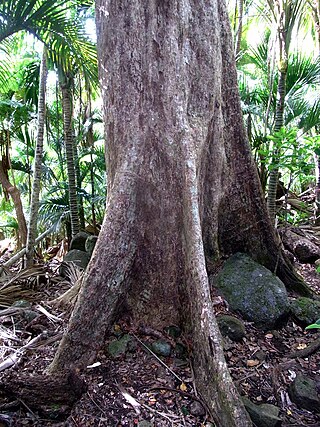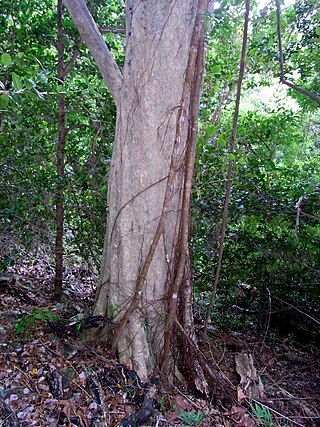
Leptospermum is a genus of shrubs and small trees in the myrtle family Myrtaceae commonly known as tea trees, although this name is sometimes also used for some species of Melaleuca. Most species are endemic to Australia, with the greatest diversity in the south of the continent, but some are native to other parts of the world, including New Zealand and Southeast Asia. Leptospermums all have five conspicuous petals and five groups of stamens which alternate with the petals. There is a single style in the centre of the flower and the fruit is a woody capsule.

Lord Howe Island is an irregularly crescent-shaped volcanic remnant in the Tasman Sea between Australia and New Zealand, part of the Australian state of New South Wales. It lies 600 km (320 nmi) directly east of mainland Port Macquarie, 780 km (420 nmi) northeast of Sydney, and about 900 km (490 nmi) southwest of Norfolk Island. It is about 10 km (6.2 mi) long and between 0.3 and 2.0 km wide with an area of 14.55 km2, though just 3.98 km2 of that comprise the low-lying developed part of the island.

Elaeocarpus is a genus of nearly five hundred species of flowering plants in the family Elaeocarpaceae native to the Western Indian Ocean, Tropical and Subtropical Asia, and the Pacific. Plants in the genus Elaeocarpus are trees or shrubs with simple leaves, flowers with four or five petals usually, and usually blue fruit.

Pimelea, commonly known as rice flowers, is a genus of plants belonging to the family Thymelaeaceae. There are about 150 species, including 110 in Australia and 36 in New Zealand.

Muehlenbeckia or maidenhair is a genus of flowering plants in the family Polygonaceae. It is native to the borders of the Pacific, including South and North America, Papua New Guinea and Australasia. It has been introduced elsewhere, including Europe. Species vary in their growth habits, many being vines or shrubs. In some environments, rampant species can become weedy and difficult to eradicate.

Acronychia is a genus of about fifty species of plants in the rue family Rutaceae. The leaves are simple or pinnate, and the flowers bisexual with four sepals, four petals and eight stamens. They have a broad distribution including in India, Malesia, Australia and the islands of the western Pacific Ocean. About twenty species are endemic to Australia.

Olearia, most commonly known as daisy-bush, is a genus of flowering plants belonging to the family Asteraceae, the largest of the flowering plant families in the world. Olearia are found in Australia, New Guinea and New Zealand. The genus includes herbaceous plants, shrubs and small trees. The latter are unusual among the Asteraceae and are called tree daisies in New Zealand. All bear the familiar daisy-like composite flowerheads in white, pink, mauve or purple.

Pomaderris is a genus of about 80 species of flowering plants in the family Rhamnaceae, the species native to Australia and/or New Zealand. Plants in the genus Pomaderris are usually shrubs, sometimes small trees with simple leaves arranged alternately along the branches and bisexual, woolly-hairy flowers arranged in racemes or panicles. The flowers are usually yellow and often lack petals.

Westringia is a genus of Australian shrubs. As with other members of the mint family their upper petal is divided into two lobes. There are four stamens - the upper two are fertile while the lower two are reduced to staminodes. The leaves are in whorls of 3 or 4.

Robert David FitzGerald was an Irish-Australian surveyor, ornithologist, botanist and poet.

Cryptandra is a genus of flowering plants family Rhamnaceae and is endemic to Australia. Most plants in the genus Cryptandra are spiny, heath-like shrubs with small, clustered leaves and flowers crowded at the ends of branches, the flowers are usually small, surrounded by brown bracts, and with tube-shaped hypanthium, the petals hooded over the anthers.

Marsdenia is a genus of plants in the family Apocynaceae first described as a genus in 1810. It is named in honor of the plant collector and Secretary of the Admiralty, William Marsden. The plants are native to tropical regions in Asia, Africa, Australia, and the Americas.

Parsonsia is a genus of woody vines in the family Apocynaceae. Species occur throughout Indomalaya, Australasia and Melanesia.

Negria is a plant genus in the family Gesneriaceae. Its only species is Negria rhabdothamnoides, commonly known as the pumpkin tree. It is related to Fieldia and Depanthus.

Syzygium fullagarii, commonly known as the scalybark, is a relatively large tree in the family Myrtaceae. It is found only on Lord Howe Island. It grows to 20 metres tall, up to an altitude of 400 metres above sea level in sheltered areas, often in rainforest. The bark is reddish brown, usually flaking to the touch. The base of the tree is often heavily buttressed. Known for many years as Cleistocalyx fullagarii, however, in recent times it has been placed in the large genus Syzygium.

Metrosideros nervulosa, commonly known as the mountain rose, is a species of flowering plant in the family Myrtaceae. It is endemic to Lord Howe Island in the Tasman Sea, part of the Australian state of New South Wales. It occurs in shrubland or low forest, mainly at altitudes of 300–875 m on the main peaks of the island. It prefers sunny positions on exposed ridges or in the forest canopy.

Zygogynum howeanum, commonly known as hotbark or hot bark, is a species of plant in the family Winteraceae. It is endemic to Australia’s subtropical Lord Howe Island in the Tasman Sea. The specific epithet refers to the locality.

Celtis conferta subsp. amblyphylla, commonly known as cotton wood or cotton-wood, is a flowering plant in the hemp and hackberry family.

Boehmeria calophleba is a flowering plant in the nettle family.
Leichhardtia is a genus of flowering plants in the dogbane family (Apocynaceae). It includes 85 species native to mainland Australia, Papuasia, New Caledonia, and Lord Howe Island.


















